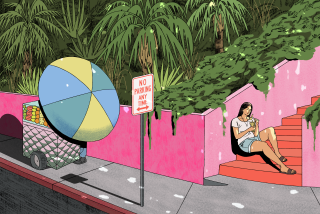An outsider’s eye on L.A.
- Share via
With the world on offer from the National Geographic, A.M. Homes chose Los Angeles. “Because it feels like one of the most American cities right now,” she said in an interview in what was her home for several months last year, the Chateau Marmont on Sunset Boulevard. “One of the themes I’m interested in is the American dream and how it has mutated.”
The operative word is theme: In “Los Angeles: People, Places, and the Castle on the Hill,” one in a new series of travel books published by National Geographic Directions, Homes explores the city as an idea, as a metaphor, not as an actual place.
“The new century began with enormous expectations, almost a sense of entitlement, for continued success, growth, the upsizing of the American Dream,” she writes. “But beneath all of this lurks the threat that the dream has become inflated, as if to compensate for all that is otherwise not happening, as if to distract us from an underlying depression -- emotional and economic; as though we are consuming, stuffing and spoiling ourselves to avoid our fear of failing, of falling, of having nothing at all.”
And Homes believes Los Angeles is America writ large. Upon arrival, the New York-based novelist rented a car and made little trips from the hotel, looking for proof of her theories about the city. Among them: Los Angeles is ultimately unknowable in its sprawl. It is unnaturally concerned with image and mortality. And, more than any other place, it is the locus of the American dream.
Of course, Homes doesn’t pretend to know the city. “I’m really an outsider,” she said, citing “inside writing” by Mike Davis and Joan Didion. “I couldn’t possibly do that. I see the city differently, and these are fragments of my L.A.”
The fragments that make up the book, which received a scathing review in this newspaper, are trips through Bel-Air and down Fairfax Avenue (where she marvels at retirement homes in a city where people refuse to grow old), as well as interviews with local residents, including Dr. Fred Kogen, a Beverly Hills mohel, a group of Hollywood retirees at the Motion Picture and Television Fund Retirement Community; and Tom Henyey, a geophysicist at USC, in a visit inspired by a sign in the Chateau Marmont elevator, reading “In case of earthquake, please remain calm.” (Homes noted that it was this chapter, on the geology of L.A., that the National Geographic editors were most eager to cut.) The final interview in the book is with Mark Bennett, a Beverly Hills mailman and artist who, from memory, sketches architectural floor plans of the homes of classic television families, from the Ricardos to the Bradys. His obsession with idealized domestic life loops back to the idea Homes outlines in the preface: “Simultaneously a city of the future and the past, the American Dream continues to thrive here and the city remains a mythological mecca, an epicenter for visionaries, romantics and dreamers. And Los Angeles is perhaps the most surreal place in America. In fact and fiction, its landscape, hills, and valleys are the backdrop against which our postmodern lifestyle plays itself out and our national anxieties and influences are thrown into relief.”
If you were wondering about the meaning of your ZIP Code, there it is.
Of course, Homes doesn’t pretend to be a travel writer. Her metier is fiction, and the fiction she found inspiration for here is much more interesting than the interviews and day trips.
“I feel my strength is observation,” she said, adding that the city “drew my work out.”
While here, Homes wrote four short stories, included in her new collection, “Things You Need to Know” (HarperCollins, 2002). Among them is a portrait of Ronald and Nancy Reagan’s marriage, as the former president’s mind is dissolved by Alzheimer’s disease. As she drove around Bel-Air, Homes said, she was struck by the image of garbage bins in front of stately mansions. That image -- the juxtaposition of privilege and the realities of everyday life -- inspired “The Former First Lady and the Football Hero,” a keen description of a public life turned intensely private.
Other stories were inspired by “the surrealism of life in L.A., the highway and the modern homes that are unique to L.A.”
The author of four novels -- including the controversial “The End of Alice” (Scribner, 1996), narrated by a pedophile -- and two collections of short stories, Homes has been compared to John Cheever, because their characters are similarly disconnected from place, history and one another. And if Cheever’s suburbia is the classic metaphor for a sense of disconnect, L.A. is for her a postmodern hyper-suburbia, fragmented and ever-expanding. In short, a logical destination for a writer like Homes. Her next novel, she said, will likely be set in L.A. “It’s a very important city, but it’s often dismissed as La-La Land,” she said, adding that her National Geographic book is a fiction writer’s take on the travelogue: “an exploration, in the way I explore the literal landscape and the people,” she said. “It was a quiet adventure. No polar bears or saber-toothed tigers.”
But then it’s very hard to stretch a saber-toothed tiger into a metaphor about modern life.
More to Read
Sign up for our Book Club newsletter
Get the latest news, events and more from the Los Angeles Times Book Club, and help us get L.A. reading and talking.
You may occasionally receive promotional content from the Los Angeles Times.







